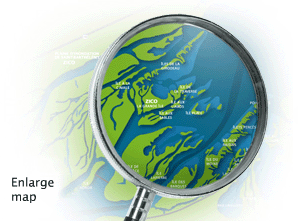|

Large gatherings and flights of waterfowl mark the approach of their autumn migration.
-------------------------------------------------------------------------------------------------------------------------
Some species choose to relax in wet meadows and marshes to rest and feed. They are storing up energy for their long trip south.
-------------------------------------------------------------------------------------------------------------------------
Though less numerous at this time of year than during their spring migration, Snow Geese visit the marshes of Baie-du-Febvre.
-------------------------------------------------------------------------------------------------------------------------
This domestic goose is larger than the wild species. It lives in an enclosure near the Centre d’interprétation de Baie-du-Febvre.
-------------------------------------------------------------------------------------------------------------------------
By the time of fall migration, many species of ducks, Canada Geese, and Snow Geese gather in large numbers at the Nicolet Migratory Bird Sanctuary.
-------------------------------------------------------------------------------------------------------------------------
This territory is the property of the Department of National Defence and, since the nineteen-fifties, access is forbidden. Some managed marshes were created in this sector by Ducks Unlimited to encourage breeding of waterfowl and to provide a rest area for them.

-------------------------------------------------------------------------------------------------------------------------
This Lesser Scaup feeds on plants and many invertebrates that live in the aquatic plant community of Lavallière Bay.
-------------------------------------------------------------------------------------------------------------------------
In the managed marshes of Baie-du-Febvre, a large variety of ducks can be observed, including both diving and wading species.
-------------------------------------------------------------------------------------------------------------------------
Wood Duck gets its name from its skill
at nesting in trees. The male’s spectacular colours
don’t go unnoticed.
-------------------------------------------------------------------------------------------------------------------------
The Northern Pintail has a long slender neck; its slenderness is accentuated by a thin white line on its plumage, extending to the side of its head.
-------------------------------------------------------------------------------------------------------------------------
Double-crested Cormorants gather with Ring-billed Gulls, Herring Gulls, and Great Black-backed Gulls.
-------------------------------------------------------------------------------------------------------------------------
The Greater Yellowlegs paces back and forth on the banks, searching for food. It is so absorbed in this activity that it is easily approached.
Links |